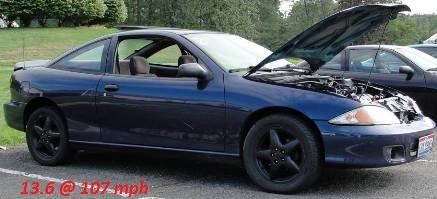so lately ive been looking into cryotreating and nitriding some items. i am relatively new to anything to do with sort of thing. ive read that both can increase strength and in some cases horsepower as well.
anybody know much about this stuff? im thinking about having a few items done for my built LD9 project im currently balls deep into. the way i see it our engines could greatly benefit from cryotreating. our timing chains stretch pretty badly, what if by doing this that is eliminated? that is just one example... i think i may go ahead and do my timing chain, lifters, and possibly the valve springs.
here is what i have found so far...
from nwcryo.com:
Cryotreatment...
The Cryogenic treatment is a one time stress relieving process that tightens grain structure, improving the path of energy and creating a denser microstructure while increasing surface area. This provides increased stress relief and dimensional stability resulting in components that last longer and perform better. For motorsports this means longer lasting parts with less fatigue and breakage while increasing horsepower, torque and time between rebuilds.
Engines
Treated engine components will have increases wear resistance, but the real gain is in relief of residual stresses. Every part and component undergoes extreme machining, forging, casting, and forming during manufacturing, all of which induce residual stress into the component. During operation, an engine undergoes immense heat and pressures every time the spark plug fires, the fuel ignites and combustion occurs. The heat build-up and dimensional forces are the causes of friction, wear, and uneven power utilization which are the primary factors in overall engine performance and life expectancy. Cryogenics can help evercome these manufacturing "flaws" and internal stresses imposed on the engine by tightening grain structure, reducing internal vibration, transferring energy more efficiently and dissipating heat faster. This allows the engine to run smoother, cooler, more efficiently and best of all helps reduce engine failure.
now, i dont know a whole lot about nitriding other than what i read in a scat catalog. they seemed to have a major hard on over it and say its the best. but i still have no idea which one is better.
any ideas people?
 If it takes forever.... I will die trying. Underdog Racing
If it takes forever.... I will die trying. Underdog Racing
I have never seen a issue with a LD9 timing chain stretching, so not sure I would do that, but rods yes.
 FU Tuning
FU Tuning
wow obviously you havent built enough LD9's then. ive seen plenty of them stretch, its no picnic.

 If it takes forever.... I will die trying. Underdog Racing
If it takes forever.... I will die trying. Underdog Racing
When I did the secret cams in my 01 my chain was stretched so bad I couldnt line it back up dead on. 140k on it at the time and had been very well maintained. New chain and everything lined up perfectly.
I will most likely get some type of surface treatment done on various parts of my new motor also.

z yaaaa wrote:wow obviously you havent built enough LD9's then. ive seen plenty of them stretch, its no picnic. 
I have worked on plenty. Only one I could not get timed correctly. Reaper. Head had been shaved twince that I know of and maybe 2 times, so I'm sure that was it. Done cams on plenty etc... Still never had that issue.
 FU Tuning
FU Tuning
The timing chain stretching is news to me as well.
I have no signiture
every LD9 ive been into has had a streched chain( if it was OEM). The worst one ive seen was 1.5 links longer than the replacement. People come into the store working on them, please for the love of god replace the chain lol. if you cant buy the whole kits at least half ass it and buy a chain. $32 insurance.

and please for the love of god by the CLOYES setup. its the best.
anyways, enough about the timing chains. does anyone have any input here? or am i just talking to a wall.

 If it takes forever.... I will die trying. Underdog Racing
If it takes forever.... I will die trying. Underdog Racing
timing chains- i've haven't had a problem with them or setting the timing.
lifters- wouldn't it change the clearence in the towers?..
springs- get stronger ones if you have a problem.
just my thoughts

I agree with the springs, I dont know how much this stuff cost to get done but it seems like it might be easier (and less of a hassel) just to get stronger ones. Also, the residual stress is desiereable in the springs because thats what gives its strenght to be stiff. The work hardening during the manufacturing process is what make a spring a spring. If you unify the microstructure you are probably comprimising strenght.
Also I doubt that there is much residual stress in parts of the engine such as the block which is cast, then heat treated to anneal the microstructure (fine grains), before being machined. The "immense heat and pressures every time the spark plug fires, the fuel ignites and combustion occurs" is actually a way of work hardening the cylinder walls. This is one reason why you break your engine in before you start beating the piss out of it, because during machining it literally cuts the grain structure therefore greatly reducing the surface strenght of the walls.
So I guess what Im saying is, some parts are designed to have residual stress and reliving it might prove detrimental to the performance of said part. So springs Id get springs of a tougher/stronger material rather than treating a lesser material.
Chris
max - it doesnt change the size or shape in any way. if it did, why would they recommend doing parts with clearances? same thing goes for engine coatings. it penetrates into the pores of the metal and does not actually add anything to the surface. ive read that nitriding can go in as deep as .020. (and for those a-holes out there

, look it up... its all in black in white. tech line coatings, swain tech.. you name it. they say it has absolutely no effect on size whatsoever, it penetrates into the porous structure of the metal)
and as far as the springs go... ive read its best for them because they maintain seat pressure for longer and do not wear out as fast.
im not to keen on these stresses etc you were referring to issacs, but i dont think these places would provide this service if it was harming engine components and causing issues. it has been known for years that cryotreating is helpful for engine parts.
 If it takes forever.... I will die trying. Underdog Racing
If it takes forever.... I will die trying. Underdog Racing
hmmm, I'd be down to do the forged steel le5 rods, maybe save me some money over carillo
 LE61T PTE6262 Powered
LE61T PTE6262 Powered 
Brad- I'm not saying its a bad idea or anything. To me it sounds pricey. What about getting a chain, lifters, springs, cam gears, ect. made from a better/stronger material? But what do i know, i'm not the man trying to build an aerotech quad 4...lol

Some of these treatment processes can be quite cheap if you are lucky enough to have a local company about to do a run of something similar to what you're doing. IE Nitriding something with the same material and similar surface area or cryotreating something with the same material and similar volume.
And yes nitriding doesnt greatly effect tolerances, the Nitrogen actually absorbs into the surface of the workpiece filling the gaps in the natural crystal structure of the steel. It creates a harder surface and one with less void, less voids means less corrosion and less stress risers. Its the same process as case hardening except that uses carbon instead of nitrogen.
1994 Saturn SL2 Home Coming Edition: backup car
2002 Chevy Cavalier LS Sport Coupe: In a Junk Yard
1995 Mazda Miata R-package Class=STR
Sponsored by:
Kronos Performance
WPI Class of '12 Mechanical Engineering
WPI SAE Risk and Sustainability Management Officer
i had a chain strech about 1.5 links after 60k miles.
if i ever tear my engine apart again imma look in to cryotreating some of the internals...

You should look in dlc coating also
Location: Montreal, Quebec
Leafy wrote:Some of these treatment processes can be quite cheap if you are lucky enough to have a local company about to do a run of something similar to what you're doing. IE Nitriding something with the same material and similar surface area or cryotreating something with the same material and similar volume.
And yes nitriding doesnt greatly effect tolerances, the Nitrogen actually absorbs into the surface of the workpiece filling the gaps in the natural crystal structure of the steel. It creates a harder surface and one with less void, less voids means less corrosion and less stress risers. Its the same process as case hardening except that uses carbon instead of nitrogen.
dont say that ludacris talk! JBO will castrate you!! metal is completely solid, there are no pores and nothing can be interlaced into it.
bah LOL finally someone else that knows what metals are.

so.. with the surface being that way, can one still coat it with the oil shed or other ones? i question weather or not it would keep, not being able to latch on as well. or am i back asswards?
mc - dlc coating?? explain!
and still... what is better? cryo or nitriding?
 If it takes forever.... I will die trying. Underdog Racing
If it takes forever.... I will die trying. Underdog Racing
Stress Relief Through Cryogenic Treatment
Why Cryogenic Treatment relieves residual stresses in metal and when to use it.
Residual stresses exist in all metals and metal components. But why does cryogenic treatment relieve these stresses? The answer is found in observations made by Einstein and Bose of Germany. Both of these noted physicists observed that matter is at its most relaxed state or condition when it has the least amount of kinetic energy. The process of freezing is not one of putting cold into an object. Rather, it is the removal of heat. When we remove heat, we are removing energy and slowing down the molecular activity (kinetic energy) of the object being frozen. This is evident to every high school science student who studies the effects of heat - and its removal - on water.
Absolute zero, which is –459º F or 0º Kelvin is that point where no further energy can be extracted. Many people believe that at absolute zero there is no kinetic energy at all. This is not the case. But absolute zero provides a theoretical point where matter (or material) is at its most relaxed state.
Cryogenic treatment with liquid nitrogen does not get the material to its absolute lowest temperature, but when we bring materials to –300º F to –320º F for extended periods, we have removed a large amount of the object’s latent heat, slowed down its kinetic energy, and relieved or relaxed many of the residual stresses that exist within it. At this point, cryogenic treatment has relieved residual stresses.
There are a large number of cryogenic stress relieving approaches or profiles that are in use today. We provide customers the choice of using our standard stress relieving process profile or we will follow a customized recipe. These usually involve a heating or warming cycle that is repeated multiple times in sequence.
When to use Cryogenic Stress Relief Treatment:
Every part or component has its own particular challenges, so every item should be considered individually. But, in general, the most beneficial cryogenic treatment is employed when the part is in its rough form and before final cut, polish or grind. This provides that the component is in a stabilized and stress relieved condition when critical tolerance cuts are applied. Such parts will not experience the “creep” or “walk” that is often experienced on non-cryogenically stress-relieved parts. Parts that go ”out of round “ or fail to maintain flatness on final machining will benefit from cryogenic stress relief. By using cryogenic stress relieving, manufacturing yields will increase, quality will improve, and tolerances will be held to more exacting specifications.

there is also a liquid helieum treatment wich is actuslly colder than liquid nigrogen and may yeild better results. Brad from what i have read about nitride treating. i understand its a coating from electrolesis. in a hot salt water salution they bind a specific metal i think titan\ium to the surface of your parts. its thickness is up to .0001 thick on the oart and makes the toughness somthing like 50/65. i think for cost effectiveness i would do cryogenic treatment of my parts just because it makes the entire structure stronger and not just the surface.

im pretty sure cryo just does the surface as well.
 If it takes forever.... I will die trying. Underdog Racing
If it takes forever.... I will die trying. Underdog Racing
Ok theres no way to say whats better between nitriding and crytreatment.
Cryotreat, as has been said, removes residual stresses in the part and how it actually hardens the part is very hard to explain, so I wont, lets just say it helps prevent permanent bending.
Nitriding hardens the surface of the part by changing the alloy of the steel on the surface. It is accomplished by putting the part in a chamber in a fluid with a very high Nitrogen availability, the chamber is then heated such that alloying is made easier and the Nitrogen flows from an area of high concentration (the fluid) to an area of low concentration (the center of the part). the N then ends up filling in gaps in the crystalline structure of the steel as well as changing the alloy, most of this happens withing the first few 0.001 (or less) of an inch.
The thing you were talking about with the Titanium coats is called CVD Chemical vapor deposition or PVD. And its just a coating, like those yellow Ti drill bits.
1994 Saturn SL2 Home Coming Edition: backup car
2002 Chevy Cavalier LS Sport Coupe: In a Junk Yard
1995 Mazda Miata R-package Class=STR
Sponsored by:
Kronos Performance
WPI Class of '12 Mechanical Engineering
WPI SAE Risk and Sustainability Management Officer
lol ok... cryotreat, then nitride, then coat.
that work?
 If it takes forever.... I will die trying. Underdog Racing
If it takes forever.... I will die trying. Underdog Racing
I really wouldn't consider getting engine internals nitrided, it makes the surface pretty hard and any thing thats going to have surface contact with a nitrided part is going to wear like crazy. Although I really haven't looked into any of these services for this application. I bet you can find huge retarded amounts of info on all of this on some v8 forum or some crazy articles based on v8's somewhere on the internet.
1994 Saturn SL2 Home Coming Edition: backup car
2002 Chevy Cavalier LS Sport Coupe: In a Junk Yard
1995 Mazda Miata R-package Class=STR
Sponsored by:
Kronos Performance
WPI Class of '12 Mechanical Engineering
WPI SAE Risk and Sustainability Management Officer
Arsenic can be used to fill in the crystalline structure of silicon...
I'm not a materials science guy, but it was my understanding that cryo makes parts brittle, so I'm not sure that would be wise on springs. I would think you would be better off shaving weight, while at the same time increasing strength with Ti springs.
Sorry...I can't provide any useful info on the subject

I have no signiture
















